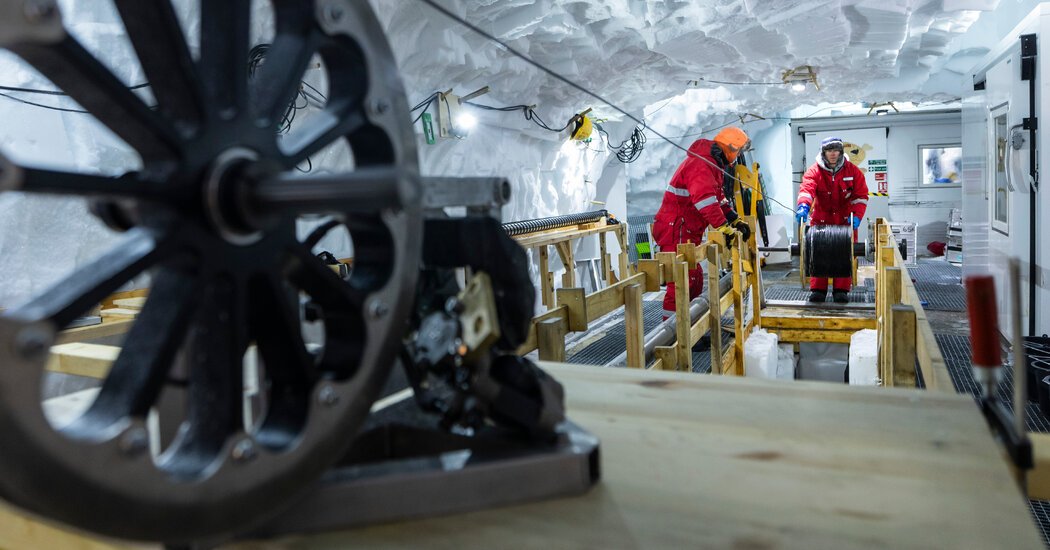In Greenland, the Ice Doesn’t Just Flow, It Quivers and Quakes
When Andreas Fichtner unspooled a fiber-optic cable into a deep hole in Greenland’s ice, he wasn’t expecting to discover a whole new way that glaciers move. Even when the cable started sending back data, his first reaction was skeptical.
“Rubbish,” Dr. Fichtner, a professor of seismology and wave physics at the Swiss university ETH Zurich, remembers thinking. “Just some electronic noise.”
This was August 2022. The field season in Greenland was almost over. The cold, the altitude, the long hours — all of it was wearing on Dr. Fichtner and his fellow researchers. But they’d been saving one of their cables for one last experiment, one that would let them measure tiny movements deep within the vast river of ice as it flowed toward the sea.
What they found raises questions about scientists’ assumptions about how the ice sheets of Greenland and Antarctica are moving and adding to sea levels worldwide.
That last cable picked up cascades of tiny “ice quakes,” some of them reverberating hundreds of feet, Dr. Fichtner and his colleagues reported on Thursday in the journal Science.
These quakes seemed to start near impurities in the ice that were deposited by volcanic eruptions, Dr. Fichtner said. Where these particles sit, the ice is weaker, more prone to cracking. Along these cracks, the ice sticks and slips and quivers as it moves, creating tiny seismic disturbances.
This isn’t what scientists usually imagine is going on inside the deep piles of ice that cover Earth’s polar regions. Typically, they think of this ice as flowing like syrup: slowly, smoothly, fluidly.
But if the ice were really moving like a uniform mass of honey, then Dr. Fichtner’s cable would have picked up “complete silence,” he said. Instead, it recorded these “really, really curious events,” he said. “That was the surprise here.”
By sending laser pulses through fiber-optic cable and measuring how they scatter, scientists can reconstruct fine movements along the cable’s entire length. This has proved useful for monitoring seismic activity, deep-sea currents, glacial ice and more.
In Greenland, Dr. Fichtner and a colleague lowered a cable by hand nearly a mile down a borehole, one that other scientists had drilled to extract an ice core. There the cable lay for 14 hours, picking up vibrations.
If winding and unwinding a cable doesn’t sound especially challenging, let Dr. Fichtner be the first to inform you: It was “serious physical work.” The borehole was filled with a special kind of vegetable oil to keep it from closing up, so the cable was slow to sink and heavy to lift back out. Plus, the subzero cold made the cable brittle, meaning they had to handle it with utmost care.
When Dr. Fichtner started looking at the readings that came back, he had to convince himself they weren’t “rubbish.” What if they showed vibrations coming from within the cable itself? Or from cracks forming in the borehole wall?
In time, he and his team concluded that they’d recorded something intrinsic to the ice. Still, Dr. Fichtner acknowledged that only by making more measurements in more places can scientists really say how commonly these quakes occur within ice sheets.
Getting enough measurements is a constant challenge for polar scientists, said Hélène Seroussi, an engineering professor at Dartmouth College in New Hampshire who wasn’t involved in the new research. When oceanographers want to collect data, they can drop instruments into the deep sea in a matter of hours. Glacier researchers have to drill deep into the ice, which takes months, even years.
“That’s why we keep finding all these new principles and mechanisms that seem relatively fundamental,” Dr. Seroussi said. “Each time you have a new observation, a new ice core, a new way of measuring, you learn something new.”
Andy Aschwanden, a glaciologist at the University of Alaska Fairbanks, said Dr. Fichtner and his colleagues’ discovery offered an interesting glimpse into the intricacies of ice physics. But he said it was too early to know whether it can help scientists better predict how quickly the melting ice sheets will lift global sea levels. The ice still holds other mysteries that, if unraveled, are likely to improve the modeling much more, Dr. Aschwanden said.
The new findings could someday help scientists better understand the way ice sheets break apart at their edges, said Richard B. Alley, a professor of geosciences at the Pennsylvania State University.
Pre-existing flaws or damage in the ice can cause it to crack up rapidly once it flows off the land and out to sea, Dr. Alley said. It’s the same reason a fast-food ketchup packet is easy to open if you do it from the little notch, but very difficult if you try to tear it anywhere else, he said.
“All of us who study ice,” Dr. Alley said, “will be building on this new paper for a long time to come.”



Post Comment